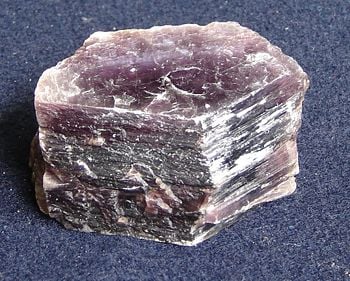Lepidolite

Once thought of as a single mineral species, lepidolite has been recently redefined as a series of minerals in the mica group.[1] Chemically, it may be referred to as potassium lithium aluminum silicate hydroxide fluoride. Its lithium content can vary, but the lithium-rich varieties form an important source of this element and are generally associated with other lithium-bearing minerals (such as spodumene) in pegmatite bodies. It is also one of the main sources of the rare alkali metals, rubidium and cesium.[2]
Occurrence
Lepidolite is often found associated with other minerals, such as spodumene, quartz, amblygonite, feldspar, and tourmaline. Noteworthy deposits have been found in Brazil; Ural Mountains, Russia; California; and Tanco Pegmatite at Bernic Lake in Manitoba, Canada.
Characteristics
The chemical formula of lepidolite may be written as KLi2Al(Al,Si)3O10(F,OH)2. It has a vitreous to pearly luster and ranges from transparent to translucent. Typically, its colors range from lilac to pale pink to white, but gray and yellow varieties have also been found occasionally. It has a hardness of about 2.5 on the Mohs scale, while its density is generally between 2.8 and 2.9, and its streak is white.
Like other micas, lepidolite is composed of layered sheets and is often found as large plates or "books." It may also be found in the form of granular masses. The sheets consist of lithium aluminum silicate and are held together by potassium ions.
The crystal structure of lepidolite belongs to the monoclinic system, and the crystal habit may be tabular or prismatic. The cleavage is perfect in one direction, producing flakes.
Uses
Lithium-rich lepidolite is a major source of the element lithium, which in turn has many applications. For instance, lithium is used in rechargeable batteries, alloys for aircraft parts, and appliances like toasters and microwave ovens. Lithium compounds are used in mobile phones, air purifiers, high-temperature lubricants, and mood-stabilizing drugs. In addition, lepidolite varieties that are enriched in rubidium or cesium serve as important sources for these rare alkali metals.
See also
Notes
- ↑ Lepidolite, Mindat.org. Retrieved May 11, 2007.
- ↑ H. Nechamkin, The Chemistry of the Elements, New York: McGraw-Hill, 1968.
ReferencesISBN links support NWE through referral fees
- Deer, W.A., R.A. Howie, and J. Zussman. 1996. An Introduction to the Rock-Forming Minerals. 2nd ed. Upper Saddle River, NJ: Prentice Hall. ISBN 0582300940.
- Farndon, John. 2006. The Practical Encyclopedia of Rocks & Minerals: How to Find, Identify, Collect and Maintain the World's best Specimens, with over 1000 Photographs and Artworks. London: Lorenz Books. ISBN 0754815412.
- Klein, Cornelis, and Barbara Dutrow. 2007. Manual of Mineral Science. 23rd ed. New York: John Wiley. ISBN 978-0471721574.
- Mineral Gallery. 2006. The Mineral Lepidolite. Amethyst Galleries.
- Pellant, Chris. 2002. Rocks and Minerals. Smithsonian Handbooks. New York: Dorling Kindersley. ISBN 0789491060.
- Shaffer, Paul R., Herbert S. Zim, and Raymond Perlman. 2001. Rocks, Gems and Minerals. Rev. ed. New York: St. Martin's Press. ISBN 1582381321.
External links
All links retrieved October 25, 2022.
- Lepidolite – Mindat.org.
Credits
New World Encyclopedia writers and editors rewrote and completed the Wikipedia article in accordance with New World Encyclopedia standards. This article abides by terms of the Creative Commons CC-by-sa 3.0 License (CC-by-sa), which may be used and disseminated with proper attribution. Credit is due under the terms of this license that can reference both the New World Encyclopedia contributors and the selfless volunteer contributors of the Wikimedia Foundation. To cite this article click here for a list of acceptable citing formats.The history of earlier contributions by wikipedians is accessible to researchers here:
The history of this article since it was imported to New World Encyclopedia:
Note: Some restrictions may apply to use of individual images which are separately licensed.